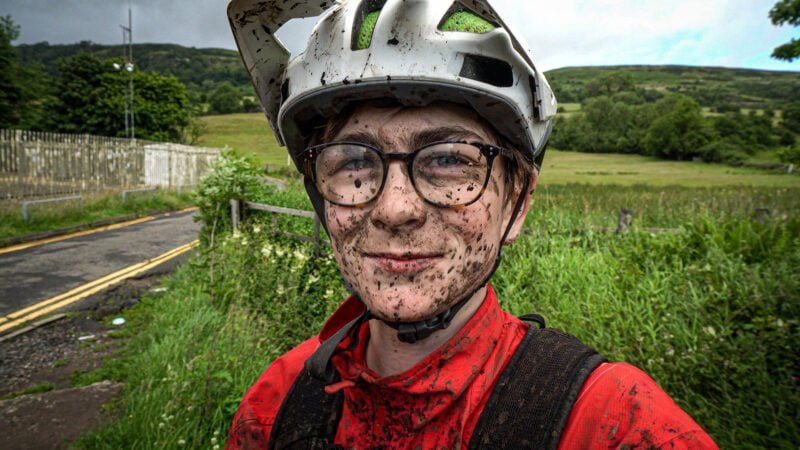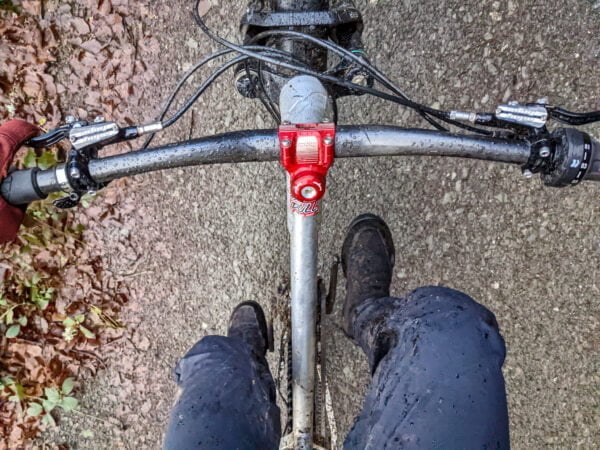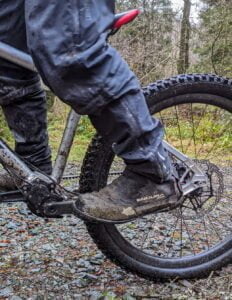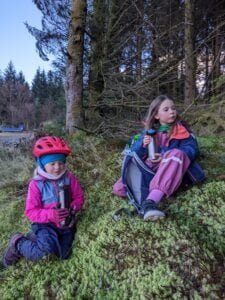Let’s face it – we live in Scotland, and if we worried about the weather then we’d never go out. We’ve all been there – gazing out the window in the morning at the dark grey mess above, looking longingly back at the cosy bed… it’s difficult to stay motivated and follow through on your best-laid plans when it looks so grim outside!
It’s all too easy to send a text with excuses and back-out of the fun you had planned – that’s a sure-fire way of feeling rubbish come lunchtime when the sun pops out, contrary to the weather forecast, and makes you feel like you’re missing out on a quality social day out on the bike getting fresh air and exercise. Especially when your friends’ follow through and post their fun times all over social media!
As our national hero Billy Connolly once said; “There’s no such thing as bad weather, just the wrong clothing, so get yourself a sexy raincoat and live a little.”
So there are your options; stay at home and sulk, or suck it up and send it!
Essential Kit
Waterproof outer layer – jacket and trousers with a high waterproof and breathability rating – anything below 15,000mm would not be considered waterproof in Scotland! A waterproof ‘onesie’ is the ultimate protection from the elements, such as the MT500 from Endura.
Waterproof gloves & overshoes – keep your hands warm and dry with proper waterproof gloves and prevent the cold water/wind from ever reaching your feet with some waterproof overshoes. We prefer overshoes to waterproof socks because it stops the socks and shoes from carrying lots of cold water, instead, repelling it from the outside.
Warm baselayer – moisture-wicking is essential in managing your body temperature and a good base layer will help get rid of excess moisture if possible!
Layers – are good. They’re adjustable depending on conditions, helping to maximise control over your body temperature and regulate sweat and hydration. If you can take a spare, it will keep you comfortable at the coffee and cake stop(s)!
Backpack – a decent size backpack (15 litres+) is the best way to carry cargo. Hip packs and other variations have their place, but can’t carry as much as comfortably as a backpack. Great for taking tools, spares, food, first aid and maybe some spare clothes. Also good for taking extra rubbish home!
Waterproof backpack cover – nothing worse than a soggy sandwich! …and rusty tools :/
Dry bags – to keep your essential equipment protected you’ll need a flexible waterproof bag to store it in. They’re also great as buoyancy aids in emergencies!
Eyewear – clear glasses or goggles will help keep your eyes grit-free from splashes that even the best mudguards cannot defend against!


Hacks & Bodges
Latex mechanic/medical gloves under regular gloves – this provides a wind/water barrier that will help keep your hands comfortable for longer when they’re extended out away from your core at the handlebars, getting pounded with fresh cold rain and howling winds!
Plastic bags under your socks (or latex socks!) for the same reason as the gloves – wind/water barrier stops the constant barrage of cold water from puddles freezing your feet.
Double-buff day – use a smartly-folded buff around your neck and one on your head to give your head a base layer! This can also protect your ears that are effectively little radiators and conduct heat away from your noggin rather quickly. A shower cap is possibly the most unfashionable (yet hilarious) option here, but in extreme cases, it can be a good choice to keep your head warm and protect you from the incessant cold rain. You can also buy balaclavas!
Blowing into a fist – warming your hands seems almost impossible when it’s baltic and soaking, but fear not! By forcing air through a tight space, you can generate enough heat to start to warm your hands, all with the power of your lungs! It’s not the heat in your breath but the molecules being compressed that generate the heat, so grip tightly and blow hard with a lot of resistance in the fist for long periods for maximum effect.
The Penguin Dance – no, we’re not asking you to all huddle your group together, faced inward to shield from the elements… it’s much worse, we’re telling you to dance! Stand tall with your arms straightened down by your side and point your hands/fingers outward from your body at 90° – move your shoulders up and down vigorously and you should feel a tingle in your hands! Keep it going and you should start to feel a little warmer in the hands.
Phone in a Bag – put your phone in a snack-size ziplock or sandwich bag to help protect it from the elements.
Heated grips – motorbikes have them, why can’t we? It’s possible to adapt a motorcycle-based system to work for mtb grips.


Bike Setup & Equipment
Wet lube – when the drivetrain is being constantly rinsed, a thicker, stickier lubrication is required so it doesn’t get washed off so fast.
Mud/spike tyres – if riding natural trails where it is likely to be very muddy or in sub-zero conditions with ice, changing your tyres can make a world of difference, not only to your riding experience, but for your safety too – especially when it comes to ice!
Mudguards – keep that fresh spray off your bahookie! Fresh cold water at the splash of every puddle is a heat-thief to be prevented if possible! This may also prevent mud from getting in your eye and causing an accidental chilly detour into the loch…
Gearbox & Belt – an internal drivetrain will prevent the horrible conditions from disrupting your gear efficiency and shifting, as well as prevent failure. It’s a no brainer!
Suspension – cold temperatures mean that the oil in your bouncy bits will be thicker and more viscous, meaning it will travel through a damper much slower, effectively increasing your damping by many clicks! Compensate by reducing the damping (making it move faster, usually towards the rabbit rather than the turtle!) by a few clicks if you feel your suspension is harsh.
Bike Wash – best to do it immediately after a ride, before it dries in, and make sure you dry and re-lube your drivetrain afterwards to protect and prolong. It may be the last thing you want to do after a cold and wet ride, but nobody ever regrets doing it right away!
Posthumous maintenance – you MUST service your bike after prolonged use in harsh conditions – or even short term use in really awful conditions! A quick strip-down and re-grease of all moving parts (inc suspension and dropper post servicing) will go a long way to preventing premature wear on expensive components.
Spares – take spare brake pads, inner cables and plenty zip ties. Crud causes friction in moving parts so when resistance is ramped up, you’re putting more stress into shifters etc, and coupled with the cold, plastic is more brittle and prone to breaking.


Bonus Tips
Keep moving – maintaining a consistently high heart rate keeps the central heating on!
Fuel fast – keep the central heating beating with plenty of regular and nutritious food and drink. Don’t underestimate how much energy you consume just by being cold!
Take off wet kit – having water making contact with your body will draw heat away faster than a fridge, especially if it’s windy!
Re-proof your kit – water-repellant coatings (DWR) wear over time and the fabric membrane gets dirt and particles that affect the ability to repel water. By using a deep cleaner and a re-proofer you can extend the usable life of your waterproof kit.
Eliminate faff – minimising any bike setup or mechanics pre-ride, preventing any mechanicals when out riding with proactive maintenance, or having your bike-washing kit prepared for afterwards will help minimise your exposure to the cold before, during and after your ride – splash and dash!
Consider elevation and location – staying sheltered and lower down will help minimise the possibility of extreme weather with every 100m of elevation losing a degree of temperature! Being in the forest also provides natural protection from the wind and rain.
Warm your clothes before putting them on, like your mammy used to, and if returning home after your ride is an option, pre-heat the clothes you are going to change into! Even just having a warm space to get changed (van heater, central heating timer etc) will make a huge difference to your post-ride comfort and therefore positively affect your posthumous reflection on the ride.
Frozen Solid – consider what type of food you carry with you as it may get cold and difficult to eat! Frozen snacks are tasty but not efficient to consume quickly or safely – even your drinks bottle can freeze and is pretty tricky to consume when solid!


Other Useful Equipment
Hand/feet warmers – pretty handy to have when all else is sapping away the warmth! There are lots of different styles but throw some in your pockets to get a heat top-up.
Flask with a hot drink – having a source of instant heat to wrap your hands around is an ultimate soother when the extremities start to go numb!
Spare gloves – a spare pair of dry gloves is a luxury untold when your soaking digits are turning into frozen shrimps. Spare latex gloves for replacements are well worth it too!
Changing robes – are great for changing after a cold wet ride – throw it over your wet kit and get changed underneath the towel-lined garment, with room to manoeuvre and get dressed again into your casual clothes without exposing your core (or privates!) to the elements (or the rest of the car park!).













